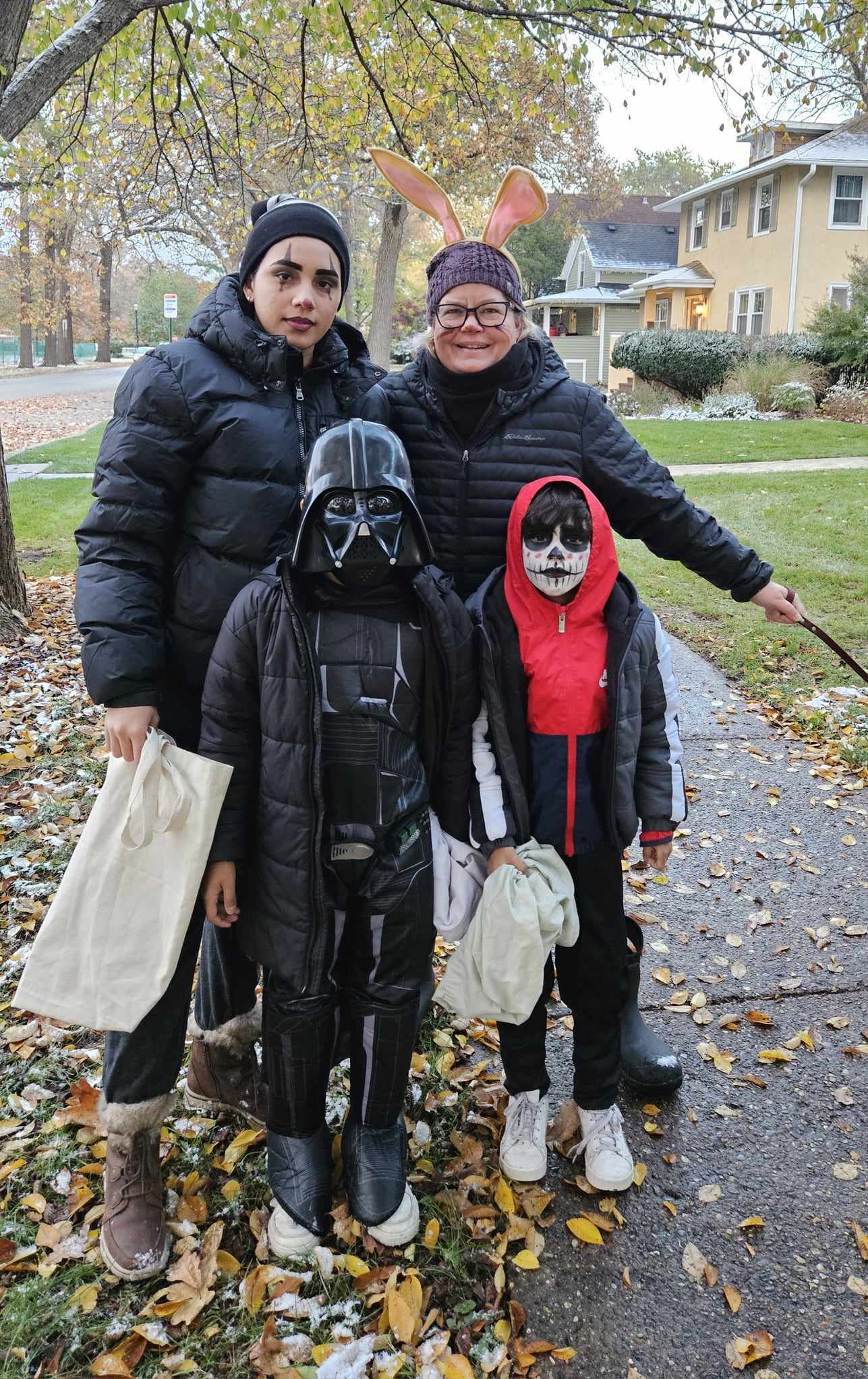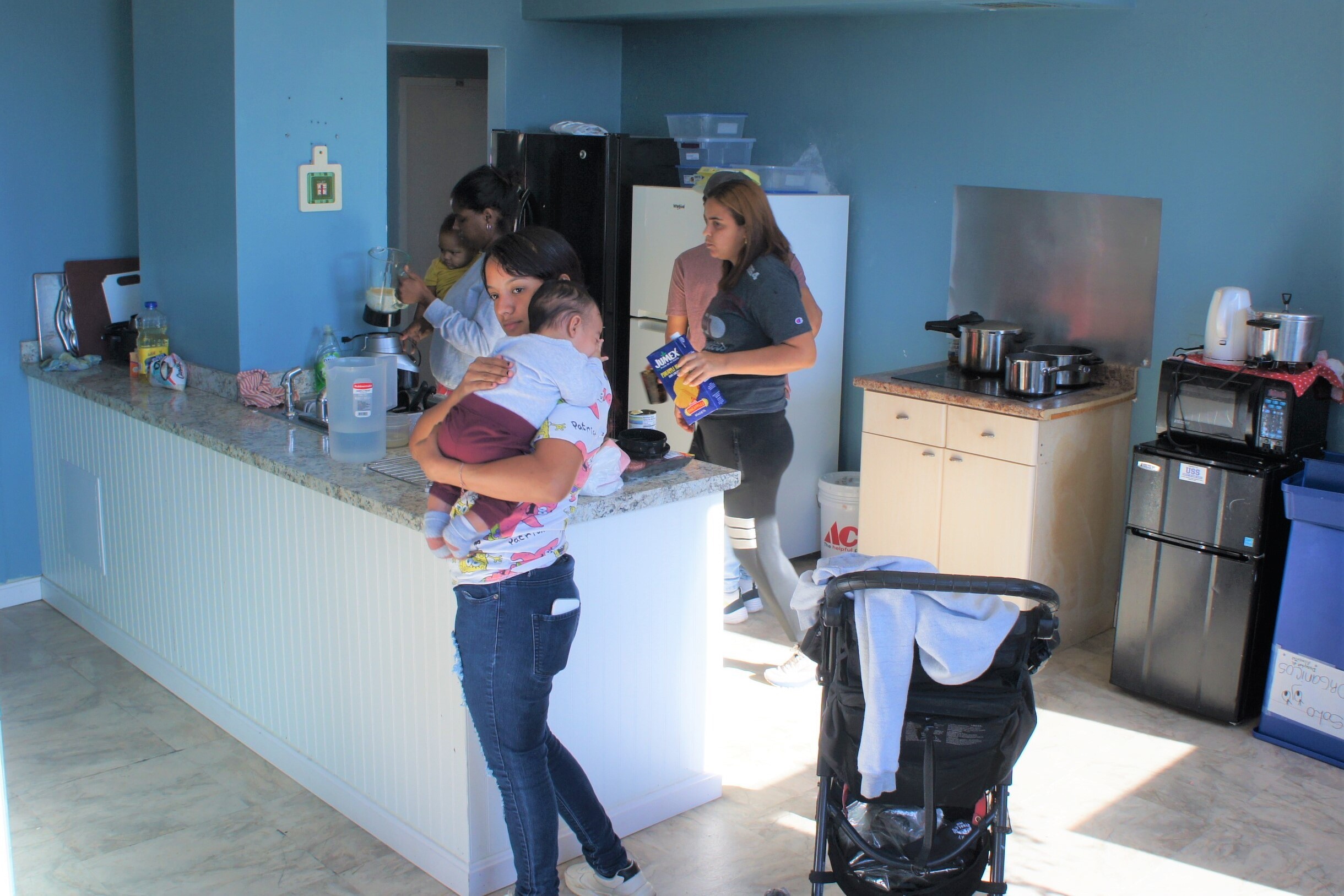Since last summer, more than 21,000 migrants, mostly from Venezuela, have been bussed from Texas to Chicago. New arrivals are staying at police stations, O’Hare Airport and city-run shelters.
With winter on the way, city officials are scrambling to find housing alternatives.
They’re considering converting a variety of buildings into living spaces and plan to build a tent encampment in Brighton Park on the Southwest Side.
But in the meantime, some asylum seekers are finding relief on a much smaller scale through semi-independent communal living.
Some of the more creative approaches include living with host families or in dorm-style spaces. Unlike city-run solutions, these communal living alternatives are not overseen by the federal or local government and instead rely on individual families and non-profit organizations to welcome migrants into their homes or buildings.
One Curious City listener wanted to know more about what life is like in these alternatives to shelters.
So we visited several families that have hosted migrants and checked out a shared living space in a mixed-use building. Advocates say both could be scaled to become sustainable models for housing migrants during this crisis.
Host families
Kevin Orozco, his wife, Michetlle, and their two children arrived in Chicago from Venezuela last winter. They didn’t know anyone in the city and had nowhere to go. So like many other migrants, they were taken to a police station where they were placed on a waitlist to get into a city shelter and receive rental assistance.
But at the shelter Orozco started to feel restless. “We were extremely uncomfortable with absolutely no privacy,” he said in Spanish.

“There was a bed and then a mattress on the floor. And that was just about all the floor space,” she said.
Kutzner Huzar was nervous about the arrangement. She walks dogs on the weekends and tutors to help pay the bills, so inviting a family of four to live with her was not exactly within her means. Plus, her home is relatively small, with just one bathroom.
But she collected donations, including clothes, for the family. She even asked a neighbor for pillows because she didn’t have extra.
Orozco and his family didn’t know what to expect, but they took a leap of faith because they were desperate. By moving in with Kutzner Huzar, they had to take their names off the waitlist to receive housing assistance from the state.
Kutzner Huzar said when the family first arrived, they slept for days. But the families soon got to know each other. They cooked and went grocery shopping together, celebrated birthdays and went sledding in the winter.
Kutzner Huzar provided the family with groceries, toiletries and took care of the increased utility bills. But she said she got a lot in return from hosting the family. Orozco is handy, she said, and would often fix things around the house. His kids, who are seven and nine years old, helped Kutzner Huzar’s youngest son with his Spanish.
Host families
Kevin Orozco, his wife, Michetlle, and their two children from Venezuela were hosted by Kristin Kutzner Huzar and her two children in Evanston, IL.
Space being shared: Single-family home in Evanston, IL
Overseen by city, state or federal gov? No. The families were connected through a local volunteer group.
Long vs. short term? Up to the host family to decide. The Orozcos stayed with the Kutzner Huzar family for nine months.
Does state rental assistance apply? No. Migrant families forfeit their place on waitlist for state rental assistance by living with a host family.
Cost to host family? Groceries, toiletries, household basics and increased utility bills. Kutzner Huzar solicited donations for clothes and bedroom furnishings for the Orozcos.
Cost to migrant family? Kutzner Huzar did not charge the Orozcos to live in her home. After he started picking up work, Kevin Orozco contributed to living expenses.
Eventually, Orozco started picking up construction jobs, and was able to sign a lease on an apartment down the block. Kutzner Huzar led a fundraiser to help the family pay for the first eight months of rent.
The Orozco family had a good experience with their host family, but because it isn’t an official arrangement, there’s a lot that can go wrong with little help.
That’s what Ignacio Becerril and his wife Patricia Buenrostro found out when they invited people to stay in their finished basement in Garfield Park.
The couple had been helping migrants by giving them rides. They wanted to do more because Becerril knows what it’s like to start with nothing: he came to the U.S. from Mexico as an undocumented teenager.
“I know what it’s like not to have a place to live,” Becerril said in Spanish.
Five migrants stayed with them for five months. They all pitched in for expenses and went grocery shopping together. But eventually, the temporary living arrangement became tense when the guests stopped getting along. Becerril and Buenrostro didn’t know how to navigate that.
Becerril said he doesn’t regret helping, but it’s not something he recommends. Buenrostro, on the other hand, said she would do it again if she knew she had outside support from an organization or a government agency.
“It’s a lot safer for a person or a family to sponsor asylum seekers if the government formalizes a program,” Buenrostro said in Spanish.
Experts say the host family model can work. For example, official programs have matched refugees from Afghanistan and Ukraine with host families. But they also say expectations need to be clear from the beginning.
“It's really important to think about your house rules … for both your private space and your shared space, " said Holly Tseng, the regional director of volunteer engagement at World Relief, which facilitates a host-family program for refugees and helps find housing for asylum seekers.
Shared living spaces
As city officials look for solutions to housing migrants, a major challenge is the lack of affordable housing. The housing market has become more expensive, and large apartment complexes no longer have the vacancies they once had.
But some organizations that own large buildings in the city are converting them into shared living spaces for recently arrived migrants.
Margaret Gergen is involved with affordable housing initiatives across the city and sits on the board of a Chicago-based non-profit. Earlier this year, her organization was trying to figure out what to do with parts of a mixed-use building it owned in the Uptown neighborhood.
“We were thinking, how could we use this space? Should we redesign it and turn it into offices?” said Gergen.
Gergen connected with Park Community Church, which helps migrants find housing and other basic necessities. Together, the two organizations converted one of the floors of the building into a shared living space that could house 12 migrant families.

Because there’s been pushback in neighborhoods across Chicago in response to migrant shelters, Gergen’s organization has not publicly announced that the building is being used to house migrants. She spoke to Curious City on the condition we not name her organization or disclose the building’s location.
Most of the migrant families living in the building today waited in city shelters for months before being placed in the Uptown shared living space. They each have their own dorm-style rooms, and share two kitchens, dining spaces and bathrooms.
This housing alternative has been a relief for Cherri and her four-year-old son, Dominic. Curious City is not using their full names to protect their privacy.
Shared living spaces
Cherri and her son, Dominic, from Venezuela currently live with 11 other migrant families in an Uptown shared living space owned by a non-profit organization.
Space being shared: Large, privately owned building with 12 individual units and shared common spaces
Overseen by city, state or federal gov? No. The building is owned by a non-profit organization that oversees the space along with a local church.
Long vs. short term? The organization that owns the building allows families to stay for up to one year.
Does state rental assistance apply? Yes. Families are able to receive state rental assistance while living in this shared living space.
Cost to host organization? The non-profit that owns the building covers general building maintenance.
Cost to migrant family? Families pay $400-800 in monthly rent, depending on the size of the family. Some use state rental assistance funds to cover rent.
Cherri said she’s grateful she had a place to stay at one of the city’s shelters when she arrived in Chicago, but living with so many people in one space was challenging. “It’s loud and children have a difficult time getting to sleep,” she said in Spanish.
The non-profit organization that owns the building charges families between $400 and $800 in rent per month, depending on the size of the family. Some families living in the shared living space receive rental assistance through the Illinois Housing Development Authority’s rental assistance program. Others receive rent assistance through independent donations.
Gergen said the non-profit organization allows families to stay in the shared living space for up to one year, with the hope that they’ll become financially independent and move out after that.
“We thought, perhaps it could be an answer to the migrant situation because people are wanting to get out of shelters. But they may not be ready to take on living independently in their own apartments [right away],” Gergen explained.
At the Uptown shared living space, the newcomers build a community and learn how to navigate life in their new city. Gergen’s organization and the church plan to offer free financial literacy and English classes, homework help for children and education on how to navigate tenant agreements.
It’s hard to quantify how many shared living spaces are currently operating in the city.
But Gergen said she hopes city officials move away from thinking about barracks-type housing and towards housing that is more family- and individual-oriented. She sees potential in unused dormitories, unused schools and other large buildings that can house multiple families while also offering them some privacy.
Adriana Cardona-Maguigad is Curious City’s reporter. Follow her on Twitter @WBEZCuriousCity and @AdrianaCardMag.


